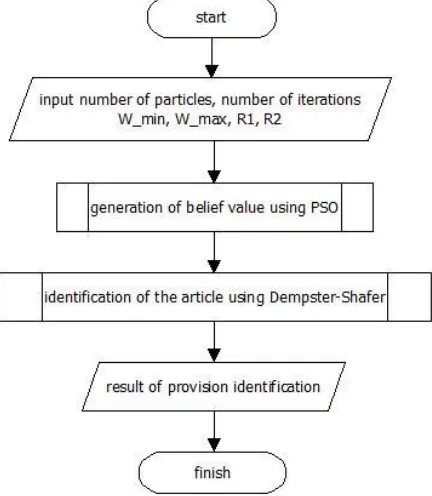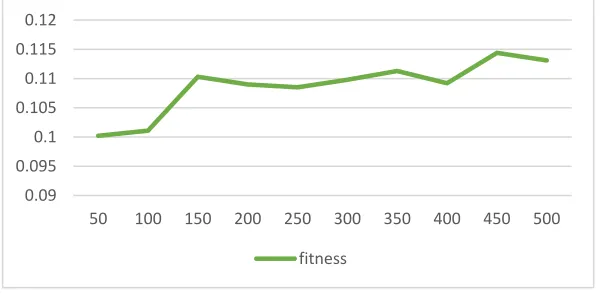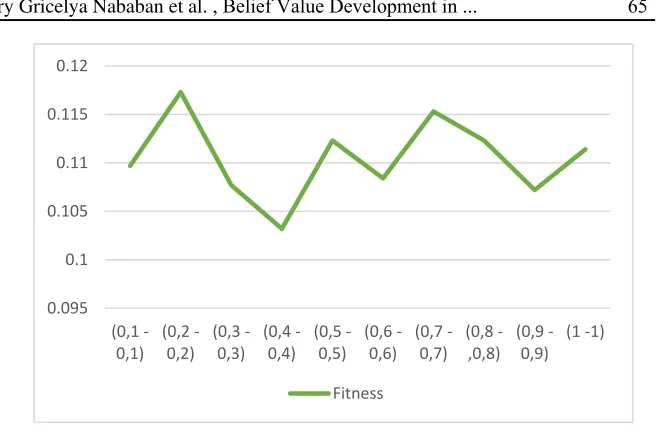Journal Homepage: www.jitecs.ub.ac.id
Belief Value Development In Dempster-Shafer With
Particle Swarm Optimization(PSO) For Determining Of
The Provision On Cases Of Persecution
Merry Gricelya Nababan1, Rekyan Regasari Mardi Putri2, Yusuf Priyo Anggodo3
Dept. Informatic, Computer Sicene, Faculty of Computer Science, University of Brawijaya Veteran Road. 8, 65145 Malang, Indonesia
1[email protected], 2[email protected], 3[email protected]
Received 10 May 2017 ; accepted 13 November 2017
Abstract. The problem of uncertainty often becomes an obstacle, especially in terms of diagnosing the provision in this study. There is an algorithm that can solve this problem is Dempster-shafer (D-S), this algorithm has belief value that serves to determine the influence between symptoms. Belief value is obtained from experts, when there are new symptoms must have to ask the experts to know the value of belief, and takes time as well. So the Particle Swarm Optimization (PSO) algorithm will help generate and optimize the value of belief in D-S. PSO is able to produce optimal belief value. This research is to generate value belief D-S with PSO.
1
Introduction
Indonesia is one of the developing countries that already has its own rules on criminal law namely the Criminal Code (KUHP) which contains provisions relating to regulate criminal law. Along with the development of civilization, the main purpose of he criminal law is to ensure people feel safe and comfortable[1]. Persecution is a deliberate act with a specific purpose, the act can be demonstrated by the presence of injuries to others resulting in pain and suffering outside the boundaries of humanity[2]. In Lingtogareng's study[3], it is not easy to make a decision that a defendant is legally guilty, and that a judge must be able to make an objective decision, which means to see from many sides to consider[4]. Thus the judge has a great responsibility to the defendant being handled[4]. That is why a solution is needed to assist the judge in deciding the sentence for the defendant.
This problem can be solved with the help of today's emerging technology, which is implementing methods that can overcome the problem of uncertainty. There are several methods to solve uncertainty problems, one of which is the Dempster-Shafer (D-S) method. The D-S method is a method that can be used to diagnose inconsistent circumstances due to the reduction or addition of new facts that will provide changes to existing rules[5].
60 JITeCS Volume 2, Number 4, 2017, pp 59-66
The value of this belief is obtained from experts, but in this study the data studied is the provisions in the criminal law of an expert can not give a belief value. So used PSO to generate its belief value as well as for optimization. PSO is an algorithm that is inspired by the movement of information and social behavior observed in the herd of deserts and fish[8].
Particle swarm optimization is one of the meta-heuristics methods that focus on local search so that in small search space can find optimal solution[9]. In the PSO the set of candidate solutions for optimization is defined as a set of particles contained in the search space[10]. In this study D-S will function for the determination of the provisions, its belief value will be raised with the PSO so as to get the optimal belief value on the D-S and give maximum accuracy result.
2.1
Dempster-Shafer (D-S)
The Dempster-Shafer method is also known as the theory of belief function. The Dempster-Shafer theory was introduced when experimenting to adapt probability theory into expert systems[11].
Belief is a measure of the strength of evidence in favor of a set of propositions. If the value of 0 (zero) then indicates that there is no evidence, and if the value of 1 indicates a certainty. Below function formulas can be formulated:
X YY
m
X
Bel
(
)
(
)
, (1)Whereas Plausibility (Pls) can be formulated as[12]:
' ) ' ( 1 ) ' ( 1 ) ( X Y X m X Bel XPls , (2)
Plausibility is also 0 to 1, if we believe in X' then it can be said Belief X' = 1 so from the above formula Pls X = 0. In Dempster-Shafer theory also known as frame of discernment denoted by .
} ,... 2 , 1
{
n
, (3)
The environment contains elements that describe the possibility of an answer and there is only one that will fit the required answer. This possibility in Dempster-Shafer theory is called the power set and denoted by P (
), each element in this power set has an interval value of 0 to 1.m = P(
) [0,1], (4)so it can be formulated:
) ( ( ) 1 ) ( 1 ) ( PX X P
X m X
m
, (5)
Dempster's Rule of Combination.
Z Y XY
m
X
m
Z
m
m
1
2
(
)
1
(
)
2
(
)
, (6)In general the formulations for Dempster's Rule of Combination are:
k Y m X m Z m
m X Y Z
1 ) ( 2 ) ( 1 ) ( 21 , (7)
The amount of evidential conflict k is formulated by:
Y XY
m
X
m
k
1
(
)
2
(
)
, (8)So that if equation (8) is substituted into equation (7) it would be:
Y X Z Y XY
m
X
m
Y
m
X
m
Z
m
m
)
(
2
)
(
1
1
)
(
2
)
(
1
)
(
2
1
, (9)2.2 Particle Swarm Optimization
The Particle Swarm Optimization algorithm is an algorithm with evolutionary computing techniques that is motivated through a set of social behaviors. The algorithm was first introduced by Kennedy and Eberhart in 1995[13]. The Particle Swarm Optimization algorithm will model the best solution activity in the search space, the particle position contained in the solution space is the optimization variables used as the optimization candidate. Each of these positions will be linked to the objective value or referred to as the fitness value[14]. Particle Swarm Optimization differs from other optimization algorithms because it does not use the information gradient in the search of a solution so that it does not result in continuous functionality error[15].
There are several stages in the implementation of the PSO algorithm, the following are the stages in the PSO:
1. Initialize the population of particles by position and velocity randomly in a space of search dimension.
2. Evaluate the desired fitness function for D-S computing optimization within the variables on each particle
3. Compare the evaluation of particle fitness with its Pbest. If the value is better than the Pbest value, then the value will be set as Pbest.
4. Update Velocity and position for each particle
5. Return to step 2 until the criteria are met, usually stopping at a fairly good fitness value or arriving at the maximum number of iterations [13].
Each particle will retain its position, consisting of fitness that has been evaluated. In addition, each particle can remember the best fitness value ever achieved during the operation of the algorithm, which is called the best particle fitness and the fitness solution is called the best position of the particle (Pbest). The PSO algorithm will also maintain the best overall fitness value referred to as (Gbest)[10].
To make a change in the speed of the PSO algorithm is represented in equation 10.
𝑉𝑖𝑘+1= 𝑊𝑉𝑖𝑘+ 𝐶1 𝑟𝑎𝑛𝑑1 × (𝑃𝑏𝑒𝑠𝑡 − 𝑋𝑖𝑘) + 𝐶2 𝑟𝑎𝑛𝑑2(𝐺𝑏𝑒𝑠𝑡 − 𝑋𝑖𝑘 , (10)
Inertia weight is introduced by Shi and Eberhart, which is used to balance local exploration that serves to reduce weights during the iteration and allows algorithms to exploit some specific areas[16].
62 JITeCS Volume 2, Number 4, 2017, pp 59-66
W=𝑊𝑚𝑎𝑥 -𝑤𝑚𝑎𝑥−𝑤𝑚𝑖𝑛
𝑖𝑡𝑒𝑟 𝑚𝑎𝑥 𝑥 𝑖𝑡𝑒𝑟, (11)
As the velocity changes, there are also changes in agent positions for each iteration that can be calculated by the following 12 [14].
𝑋𝑖𝑘+1= 𝑋𝑖𝑘+𝑉𝑖𝑘+1, (12)
2.3 Optimation belief value of D-S using PSO
In the process flow stage of system design, there is an explanation of how the process that occurs in the generation of belief D-S with PSO, shown by Figure 4.1 below.
1. The first step is to inisialition the number of particles, the number of iterations, the value of weight minimal (w_min), weight maximal (w_max), koefisien akseleration (c1, c2), random value strat from 0 until 1( r1, r2)
2. PSO algorithm will generate belief value
3. After can beliefnya value, it will be calculated by ds algorithm 4. Then will get the results of identification
2.4 Particle Representation
In this study the particle is represented by using real code coding. Particles will be generated randomly at intervals of 0.0 to 1.0. The initialization of the particle is represented in the form of an array containing cases of 17 chapters. The following will be shown particle representation in Table 2.1.
In Table 2.1 is the initialization of the particles. The above value is the belief value of each case made randomly, and there are also some empty values meaning the case does not imply a clause.
3 Experimental and result
3.1 Result and Discussion
Tests were performed on all PSO parameters, ie number of particles, number of iterations, minimum weight (w_min) and maximum weight (w_max), number of v_max
and v_min. This test is done 5 times. This is done in order to get the best fitness value in the generation of belief value in the D-S. This graphic image is the result of parameter testing on fitness value, particle count, iteration, acceleration weight, and speed. The greater the number of possible parameters can result in greater fitness value but requires longer computation time. Based on the tests that have been done the large number of parameters does not always result in a good amount of fitness as well. Another thing happens because the nature of the PSO is stochastic or random.
Figure 3. 1 Testing the number of particles to the fitness value
Based on the graph in Figure 3.1, it can be seen that the size of the number of particles has an influence on the fitness value of the algorithm. From the results of this test in getting the maximum fitness value on 450 particles.
0.09 0.095 0.1 0.105 0.11 0.115 0.12
50 100 150 200 250 300 350 400 450 500
fitness
Indication 1 Indication 2 ... Indication 14
P1 P2 P3 … P17 P1 P2 ... P17 ... P1 P2 … P17
64 JITeCS Volume 2, Number 4, 2017, pp 59-66
Figure 3. 2. Testing the number of particles to the fitness value
Figure 3. 3Testing W_min and W_max
0.104 0.106 0.108 0.11 0.112 0.114 0.116 0.118 0.12
50 100 150 200 250
fitness
0.098 0.1 0.102 0.104 0.106 0.108 0.11 0.112
(0,2 0,7)
(0,2 0,8)
(0,2 0,9)
(0,3 0,7)
(0,3 0,8)
(0,3 0,9)
(0,4 0,7)
(0,4 0,8)
(0,4 0,9)
Figure 3. 4Testing V_min and V_max`
From the test obtained the maximum number of particles is 450, the maximum number of iterations is 100, w_max is 0.8, w_min is 0.4, v_max is 0.2 and v_min is -0.2. The results of this test which will result in value belief for D-S. PSO is an algorithm that can work on a small search space, but the determination of the article for the case of maltreatment has not provided maximum results. This happens because the D-S algorithm usually resolves the problem with the output of one, on the other hand the D-S will calculate every related phenomenon in one case so that the more symptoms related to a case then the D-S will calculate that the result is not maximal.
4 Conclusion
This research is the generation of belief value in D-S with PSO for the determination of provision of case of mistreatment. Based on PSO research can generate value belief in D-S optimally. However D-S can not provide maximum results in the determination of this provision of abuse, even though the PSO has given belief value. For further research, it is recommended to use the AHP algorithm that has been research in D-S theory of evidence an alternative approach to multicriteria decision modelling[17], then can use neural network algorithm for better results.
References
1.Susanto, Riki. 2010. Hukum Pidana (Criminal Law). Depok : Universitas Indonesia.
2.Chazawi, Adami. 2000. Kejahatan Terhadap Tubuh Dan Nyawa . Malang: Rajawali Pers.
3.Lingtogareng, Jerol. 2013. Analisa Keyakinan Hakim Dalam Pengambilan Keputusan Perkara Pidana di Pengadilan. Lex Crimen. vol. 2, no. 3.
4.Sidharta, Arief. 2015. Etika Dan Kode Etik Profesi Hukum.
0.095 0.1 0.105 0.11 0.115 0.12
(0,1 -0,1)
(0,2 -0,2)
(0,3 -0,3)
(0,4 -0,4)
(0,5 -0,5)
(0,6 -0,6)
(0,7 -0,7)
(0,8 -,0,8)
(0,9 -0,9)
(1 -1)
66 JITeCS Volume 2, Number 4, 2017, pp 59-66
5.Ahmadzadeh, M.R. dan Petrou, Maria. 2001. Knowledge Fusion Based on D-S Theory. Its Application on Expert System for Software Fault Diagnosis. IEEE.
6.Yan, Ran., Li, Guoqi., Liu, Bin. 2015. Knowledge Fusion Based on D-S Theory and Its Application on Expert System for Software Fault Diagnosis. Prognostics and System Health Management Conference-Beijing.
7.Li, Feijiang, Qian, Yuhua, Wang, Jieting, Liang, Jiye. 2016. Multigranulation Information Fusion: A Dempster-Shafer Eidence Theory-Based Clustering Ensemle Method. Information Science. vol. 378, pp. 389-409.
8.Kennedy dan Eberhart, 1995. A New Optimizer Using Particle Swarm Theory. Sixth IEEE International Symposium on Micro Machine and Human Science.
9.Anggodo, Y. P. dan Mahmudy, W. F. 2017. Automatic Clustering and Optimized Fuzzt Logical Relationships For Minimum Living Needs Forecasting. Journal of Environmental Engineering & Sustainable Technology (JEEST), vol. 4, no. 01, pp. 1-7.
10.Marini dan Walzcak, 2015. Particle Swarm Optimization(PSO). A tutorial. Chemometrics and Intelligent Laboratory Systems. vol. 149, pp. 153–165.
11.Dempster, A. P. 1968 . A generalization of Bayesian inference. Journal of the Royal Statistical Society, vol. 30 pp.205-247.
12.Wu et all. 2002 . Sensor Fusion Using Dempster-Shafer Theory. EEE Instrumentation and Measurement Technology Conference.
13.Kennedy dan Eberhart, 1995. A New Optimizer Using Particle Swarm Theory.
Sixth IEEE International Symposium on Micro Machine and Human Science .
14.Marini dan Walzcak, 2015. Particle Swarm Optimization(PSO)Atutorial. Chemometrics and Intelligent Laboratory Systems. vol. 149, pp. 153–165.
15.Nouaouria, N., Boukadoum, M. Dan Proulx, R. 2013. Particle Swarm Clasification:Asurvey and Positioning. Pattern Recognition. Vol. 46. pp.2028-2044.
16.Chen H. L., Yang, Bo., Wang, Gang., Liu, Jie., Xu, Xin., Wang S. J., Liu D. Y. 2011. A novel bankruptcy prediction model based on an adaptive fuzzy k-nearest. Knowledge-Based System,vol. 24, pp.1349-1359.



